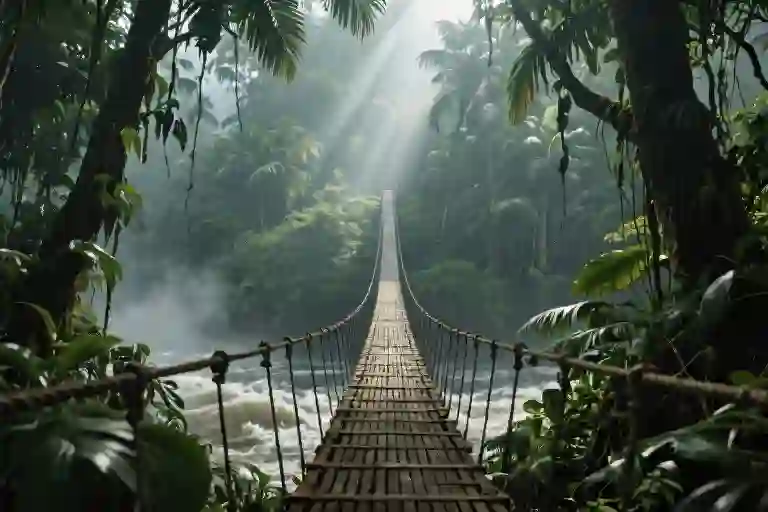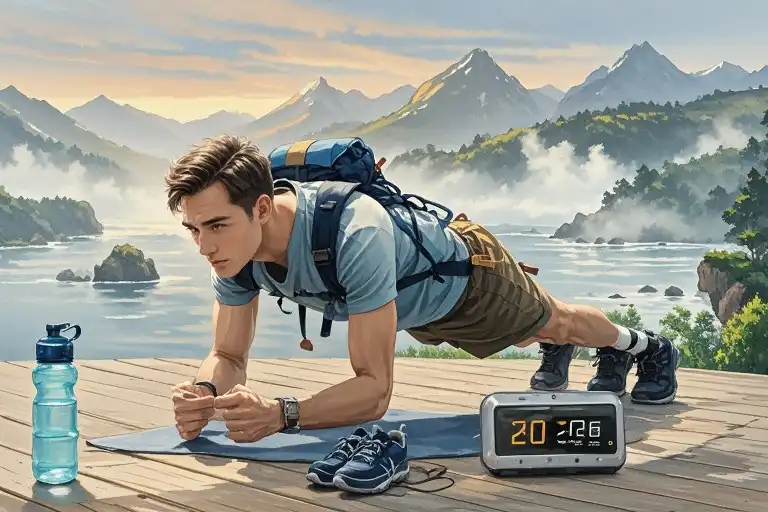Rain hammers down like bullets on the canopy as your fingers tighten around the swaying rope bridge. Every muscle burns with the effort to maintain balance while the storm tries its best to throw you into the churning river below. This isn’t just another obstacle—it’s the ultimate test of jungle confidence training, where nature becomes both opponent and teacher.
Special forces units worldwide have long understood the transformative power of such environments. Over 90% of elite military groups incorporate jungle confidence courses into their training regimens, not merely for physical conditioning but for forging mental resilience that translates to any high-pressure situation. The Singapore Armed Forces’ 72-hour endurance challenge, the Lightning Academy’s notorious canopy navigation drills, the Okinawa Jungle Warfare Training Center’s tactical simulations—each program distills centuries of survival wisdom into controlled chaos.
What makes these courses different from standard obstacle training? It’s the unpredictable synergy of environmental stressors: humidity that saps strength faster than any treadmill, limited visibility that heightens sensory awareness, and terrain that demands constant adaptation. Military researchers note a 40% faster stress adaptation rate in jungle-trained personnel compared to conventional gym-based programs—proof that true resilience grows when the body and mind face authentic challenges.
But you don’t need camouflage gear to benefit from this philosophy. The same principles that prepare soldiers for combat also help corporate teams build decisive leadership, teach outdoor enthusiasts life-saving survival skills, and push everyday people past self-imposed limits. Whether it’s learning to construct a shelter from hurricane-force winds or coordinating a team traverse across slippery vines, every element serves a dual purpose: skill acquisition and self-discovery.
So here’s the question that matters: Where does your jungle begin? Maybe it’s the boardroom where critical decisions loom like dense foliage, or the personal challenge you’ve been avoiding because it seems impassable. Jungle confidence training isn’t about becoming invincible—it’s about developing the clarity to assess risks, the creativity to solve problems with limited resources, and the composure to keep moving when every instinct screams to quit.
As the rope bridge sways violently beneath your feet, the real lesson emerges: The obstacle isn’t the bridge. It’s the story you tell yourself about what happens if you fall.
The Science Behind Jungle Confidence
There’s something primal about stepping into a jungle training course – that moment when humidity wraps around you like a second skin and the sounds of civilization fade behind dense foliage. This isn’t just about physical endurance; it’s a carefully designed neurological recalibration.
How Pressure Reshapes Your Brain
Military researchers have mapped what happens when humans face controlled adversity in jungle environments. The amygdala’s initial panic response gradually gives way to prefrontal cortex engagement – that’s your brain switching from ‘Oh no’ to ‘Let’s solve this.’ Jungle confidence courses accelerate this transition through three predictable phases:
First comes the sensory overload phase where everything feels overwhelming. Next, the adaptation period where your nervous system starts filtering irrelevant stimuli (like that persistent insect buzzing). Finally, the integration stage where you develop what special forces instructors call ‘jungle eyes’ – the ability to notice what matters while maintaining situational awareness.
Environmental Multipliers
What makes jungle training uniquely effective are environmental factors that amplify ordinary challenges:
- Humidity: At 90%+ humidity, simple movements require 30% more energy expenditure, forcing efficient motion patterns
- Sensory deprivation: Limited visibility (often under 15 meters) heightens other senses and intuition
- Circadian disruption: The lack of clear day/night markers in dense canopy areas trains mental flexibility
Researchers at Okinawa’s Jungle Warfare Training Center found these combined stressors create what they term ‘productive discomfort’ – the sweet spot where growth occurs without overwhelming participants. Their longitudinal studies show a 72-hour jungle immersion course can produce cognitive changes equivalent to six months of conventional resilience training.
Case Study: The Okinawa Method
The most compelling data comes from the Okinawa training center’s evolution of their program. After tracking over 2,000 trainees, they identified three measurable outcomes:
- Decision-making speed: Improved by 40% in high-stress scenarios
- Error correction: Participants showed 25% faster adaptation to changing conditions
- Team coordination: Non-verbal communication efficiency increased by 60%
What’s fascinating is how these gains transferred beyond the jungle. Participants reported lasting improvements in everyday stress management and problem-solving – proof that jungle training builds portable life skills, not just situational competence.
This neurological rewiring explains why financial firms in London and tech companies in Silicon Valley have adapted jungle training principles for leadership development. When your brain learns to perform under dripping heat with leeches crawling up your boots, boardroom challenges start feeling manageable.
The Anatomy of Modular Training Systems
Jungle confidence courses operate on a carefully engineered paradox: controlled chaos. The obstacle design philosophy here follows three non-negotiable principles – unpredictability demands adaptability, multimodal challenges prevent single-skill reliance, and intentional team dependence crushes individual heroics. These aren’t obstacle courses; they’re behavioral laboratories where every vine swing and mud pit serves as a diagnostic tool for human resilience.
Dynamic Equilibrium Systems
Take the Burmese bamboo bridge prototype used in Southeast Asian training programs. What appears as a simple crossing exercise actually trains six neural subsystems simultaneously: vestibular balance, peripheral vision scanning, grip endurance, panic suppression, weight distribution calculus, and environmental threat assessment (that suspicious vine might be a snake). Military trainers measure success not by completion time, but by how quickly participants recover from intentional destabilizations – because in actual jungle operations, the ground won’t politely stay still.
The Malaysian Special Forces’ iteration adds psychological warfare elements: trainees cross while instructors simulate enemy fire sounds. This conditions what survival psychologists call ‘selective focus’ – maintaining fine motor control despite adrenal overload. Civilian adaptations might replace gunfire with timed challenges or team shouting, but the neurological principle remains identical: stress inoculation through controlled system failures.
The Physics of Team Load-Bearing
Jungle operations training introduces a cruel arithmetic: 80 pounds of gear feels like 120 in 90% humidity. Standard team obstacle metrics therefore prioritize weight redistribution over raw strength. The gold standard involves:
- Rotational leadership – The point position rotates every 200 meters to prevent decision fatigue
- Load fragmentation – Critical gear gets distributed so no single failure cripples the team
- Silent communication – Hand signals replace shouts that could reveal position
Corporate teams practicing simplified versions often discover uncomfortable truths about their office dynamics. That marketing VP who dominates meetings? Watch them struggle when the supply tent’s stability depends on the intern’s knot-tying skills. Jungle obstacles have a way of flattening hierarchies faster than any diversity workshop.
Survival Skill Matrix Methodology
Modern survival training has moved beyond checklist memorization to situational algorithm development. The matrix approach teaches decision trees rather than rigid procedures:
Water Procurement Variations
- Canopy level – Vine dripping collection (requires 2+ inch diameter vegetation)
- Ground level – Solar still construction (effective but time-intensive)
- Emergency improvisation – Transpiration bags on non-toxic broadleaf plants
Each method gets color-coded by caloric expenditure versus yield, creating instinctive risk/reward calculations. Military medics report that trainees who learn this way show 40% faster field decision-making compared to traditional rote learners.
Medical Kit Minimalism
The jungle first-aid paradox: more supplies increase survival odds but decrease mobility. Elite units employ the ‘3-2-1 Rule’:
- 3 universal application items (tourniquet, hemostatic gauze, compression wrap)
- 2 environment-specific solutions (oral rehydration salts, antifungal powder)
- 1 personal wildcard (often customized for known allergies or vulnerabilities)
Adventure tourism companies have adapted this into teachable modules, emphasizing that a ziplock bag with intelligently chosen items beats an overstuffed backpack every time. The real skill isn’t packing – it’s understanding which three items would address 80% of likely emergencies in your specific environment.
What makes these systems remarkable isn’t their individual components, but how they interact. A navigation error leads to unexpected overnight stays, testing shelter skills. Shelter failures expose medical vulnerabilities. The entire experience becomes a cascading diagnostic of personal and collective weaknesses – which is precisely where genuine confidence gets forged. Not from never falling, but from developing muscle memory for getting back up when the jungle has other plans.
From Boot Camp to Boardroom: The Unexpected Journey of Jungle Training
The dense foliage of Malaysia’s rainforest still clung to Sergeant Amir’s uniform as his team emerged from a 72-hour reconnaissance mission. What surprised him wasn’t their successful operation against insurgents – that was expected after months at the Jungle Warfare Training School. The revelation came later, during debriefing, when his commander noted how seamlessly the unit had adapted their jungle navigation skills to urban terrain. This moment captures the essence of modern jungle confidence courses: their lessons ripple far beyond the vines and mud where they’re first learned.
When Bullets Meet Bamboo: Military Applications
Counterterrorism units across Southeast Asia have quietly revolutionized their training regimens by incorporating jungle confidence elements. The Malaysian Special Operations Force’s “Green Blade” program demonstrates this shift. Their modified obstacle course includes:
- Canopy-to-ground rapid deployment drills using modified rappelling techniques
- Sensory deprivation navigation (blindfolded compass work with only humidity and insect sounds as guides)
- Team medical challenges where treating heat exhaustion becomes part of the obstacle
What makes these exercises different from traditional military training? The incorporation of unpredictable natural variables. Unlike controlled shooting ranges or obstacle courses, the jungle constantly changes – a path cleared yesterday becomes overgrown by morning, a dry creek bed transforms into a raging torrent after one rainstorm. This forces operatives to develop what instructors call “adaptive confidence” – the ability to trust their skills while remaining flexible enough to modify approaches on the fly.
Boardroom Survival Skills: Corporate Adaptations
Silicon Valley’s fascination with Navy SEAL training is well-documented, but the more recent (and perhaps more practical) trend involves adapted jungle confidence elements. At a discreet retreat center near Costa Rica’s Corcovado National Park, tech executives participate in what facilitators call “CEO Canopy Challenges”:
- The Vine Swing Negotiation: Teams must trade limited resources (rope lengths, footholds) to cross an artificial gorge, mirroring startup funding negotiations
- Monkey Puzzle Decision Making: Time-sensitive problem solving while physically exhausted from previous challenges
- Ant Colony Logistics: Transporting “supplies” (actually case study materials) through obstacle courses with constantly changing rules
“We’re not teaching them to build shelters,” explains program director Elena Rodriguez. “We’re using the jungle environment to strip away corporate defenses. That moment when a Fortune 500 executive realizes they can’t PowerPoint their way through a rope bridge? That’s when real leadership breakthroughs happen.”
The Common Thread
Whether preparing soldiers for combat or executives for quarterly earnings calls, quality jungle confidence training cultivates three transferable competencies:
- Environmental Intelligence: Reading subtle changes in surroundings (whether market indicators or snapped twigs)
- Resource Fluency: Maximizing limited assets under pressure
- Adaptive Persistence: Knowing when to push through obstacles versus when to find new routes
Perhaps this explains why former participants consistently report unexpected benefits. A Singaporean finance director discovered her jungle navigation skills helped restructure department workflows. A Brazilian special forces officer applied survival prioritization techniques to disaster relief coordination. The jungle, it seems, teaches universal lessons – we just need the courage to step beneath its canopy.
Preparing for Your Jungle Challenge
The Three-Phase Fitness Plan
Getting jungle-ready doesn’t happen overnight. Think of it as preparing for a marathon where the course keeps changing beneath your feet. Phase one begins eight weeks out – focus on building foundational endurance through weighted hikes and swimming. Not the leisurely pool laps kind, but the ‘keep moving with all your clothes on’ variety that mimics tropical humidity. Twice weekly sandbag carries up hills will make those jungle ravines feel less intimidating.
Phase two kicks in at the four-week mark when you introduce instability. Balance boards during squats, blindfolded rope climbs, anything that trains your body to adapt when footing disappears. That’s when functional strength becomes more valuable than gym numbers. The final two weeks shift to specific conditioning – consecutive days of training while sleep-deprived, navigating with water rationing, essentially rehearsing discomfort.
Where to Train: Global Options Compared
The Lightning Academy’s program in Hawaii stands out for civilians seeking authentic military-style training without enlistment papers. Their 14-day course replicates about 70% of what special forces candidates experience, with medical support always present. Over in Okinawa, the Jungle Warfare Training Center offers unparalleled terrain authenticity though their shorter programs cater mainly to active military.
For those preferring less intensity, Borneo’s adventure schools provide excellent hybrid programs blending survival skills with scientific ecology lessons. The Singapore Armed Forces occasionally opens civilian slots in their renowned course – worth monitoring their defense ministry announcements. Budget-conscious options exist across Costa Rica and Malaysia, though vet their safety protocols thoroughly.
The Safety Equation You Can’t Ignore
Even seasoned athletes underestimate jungle training’s unique risks. The golden rule? Hydration needs exceed your estimates by 40% when humidity sits above 80%. Pack electrolytes beyond what you think necessary. Foot care becomes sacred ritual – merino wool socks changed twice daily, antiseptic powder applications, never ignoring the smallest hot spot.
Medical evacuation plans aren’t optional paperwork. Reputable programs will detail their emergency response times (under 90 minutes is acceptable for remote locations). Insist on seeing the guides’ wilderness first aid certifications. That reassuring military background some instructors tout means little if they can’t properly splint a compound fracture or identify heat stroke before it becomes critical.
Your gear checklist should include unexpected items: antifungal creams, waterproof not paper maps, and oddly enough – baby powder. It’s the veteran’s secret for preventing chafing when clothing stays damp for days. Most importantly, arrive with the humility to say ‘I need help’ before situations escalate. The jungle cares nothing for bravado.
Making It Personal
Customize preparations to your weakest link. If heights trigger panic, find a local ropes course before departure. Night vision poor? Practice navigation using only peripheral vision in dim light. The training will expose these gaps anyway – better to start patching them now. Keep a journal during preparation; comparing those early entries to post-course reflections often reveals the most profound changes.
Remember, no reputable program expects you to arrive fully prepared. They’re designed to break down then rebuild participants. Your job is simply arriving with enough baseline fitness to safely engage in that transformation. The rest? That’s what the screaming monkeys and slippery vines are for.
The Jungle Within and Beyond
The final rope burns on your palms haven’t even healed when the realization hits—jungle training never really ends. Those three days of mud-caked exhaustion and mosquito-bitten perseverance were just the beginning. What you carried out of that green hell wasn’t just improved navigation skills or better knot-tying techniques, but something far more valuable: the quiet certainty that when life throws its next obstacle course at you, you’ll recognize the terrain.
The Unchanging Jungle
Here’s the uncomfortable truth no training brochure will highlight: real jungles—the literal and metaphorical ones—don’t accommodate your growth. That fallen log over the ravine won’t shrink because you’ve gained confidence. Monsoon rains won’t lessen their intensity to reward your perseverance. The jungle remains magnificently indifferent, which is precisely why conquering it changes everything.
Military psychologists have a term for this—stress inoculation. Like vaccines introducing weakened viruses to build immunity, jungle courses expose participants to controlled adversity. The screaming quadriceps during hill climbs, the disorientation of night navigation, the gut-churning suspension over crocodile-infested waters (real or imagined)—these become psychological reference points. Months later, when facing a boardroom showdown or family crisis, your nervous system recalls: We’ve handled worse.
Your Obstacles, Your Story
That scar on your shin from the bamboo thicket? Keep it. The memory of being hopelessly lost until your teammate spotted the broken fern fronds you’d missed? Treasure it. These aren’t just souvenirs from an extreme vacation; they’re the foundation of a new personal narrative.
Consider how veterans of Hawaii’s Lightning Academy describe their experience: “It wasn’t about becoming Rambo. It was discovering I could be terrified and functional at the same time.” This duality—acknowledging fear while maintaining capability—translates shockingly well to civilian life. Parental anxieties, career uncertainties, even the existential dread of modern existence all become manageable when you’ve literally slept in a hammock during a tropical downpour.
Where to Next?
For those bitten by the jungle training bug (sometimes literally), the path forward branches like a liana vine:
For the Tactical Mind
- Jungle Warfare Training Center, Okinawa: Where special forces units refine their canopy movement techniques
- The Survival Instructor’s Handbook by John ‘Lofty’ Wiseman: The bible of military-grade wilderness skills
For Civilian Adventurers
- Bushmasters Australia: 14-day courses blending Aboriginal tracking with modern survival science
- Deep Jungle Challenge in Costa Rica: Corporate teams tackle cooperative obstacle courses
For the Armchair Explorer
- The Unseen Jungle podcast: Special forces medics discuss applying field medicine in urban settings
- Tribe by Sebastian Junger: On how hardship builds community bonds
The gear will rust. The calluses will fade. But that moment when you chose to step onto the swaying rope bridge instead of waiting for rescue? That stays. Because the ultimate jungle confidence course was never about mastering the environment—it was about recognizing your capacity to engage with it.
So tell me—what’s the next obstacle you’re preparing to face? And more importantly, what version of yourself will meet it?




